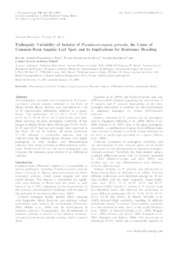Pathogenic variability of isolates of Pseudocercospora griseola, the cause of common bean angular leaf spot, and its implications for resistance breeding.
Pathogenic variability of isolates of Pseudocercospora griseola, the cause of common bean angular leaf spot, and its implications for resistance breeding.
Author(s): SILVA, K. J. D. e; SOUZA, E. A. de; SARTORATO, A.; FREIRE, C. N. de S.
Summary: The pathogenic variability was evaluated of 48 Pseudocercospora griseola isolates collected in the State of Minas Gerais, Brazil. Isolates were inoculated to a set of 12 international differential cultivars in a greenhouse. Ten pathotypes (55-15, 63-7, 63-15, 63-23, 63-25, 63-27, 63-31, 63-47, 63-55 and 63-63) were identified, showing the great pathogenic variability of this fungus in Minas Gerais State. Pathotypes 55-15, 63-15, 63-25 and 63-27 had not previously been reported in the State. Of the 48 isolates, all except pathotype 55-1547 induced a compatible reaction with all cultivars from the Andean group. Isolates were highly pathogenic in both Andean and Mesoamerican cultivars, thus being classified as Mesoamerican pathotypes. Pathotype 63-63 was the most widespread, and overcame the resistance genes present in all differential cultivars.
Publication year: 2008
Types of publication: Journal article
Unit: Embrapa Mid-North
Observation
Some of Embrapa's publications are published as ePub files. To read them, use or download one of the following free software options to your computer or mobile device. Android: Google Play Books; IOS: iBooks; Windows and Linux: Calibre.
Access other publications
Access the Agricultural Research Database (BDPA) to consult Embrapa's full library collection and records.
Visit Embrapa Bookstore to purchase books and other publications sold by Embrapa.

